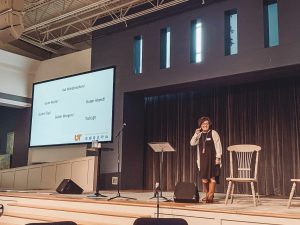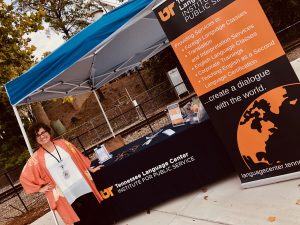I recently had the pleasure of sitting down and talking with Connie Barrow, a nurse practitioner from White House who homeschools her two kids, Wesley (age 15) and Shannon (age 13). They have been attending our classes since January and just recently completed their third term. She sits patiently in our lobby twice a week for two hours while Wesley and Shannon take their evening world language classes and has become a dear friend of ours.
One of the reasons Connie sought us out was because of her son’s interest in learning Russian. Private video lessons with an instructor based in the Ukraine sparked an interest in attending an in-person class. With a quick search on the internet, Connie found TLC.
The combination of the private tutoring and attending our in-person classes year round is how her kids achieve the required amount of homeschool credit every year. Although year round classes are a big commitment, Connie appreciates the continuity of the language learning and says it quickly became about more than just achieving the school credit – both kids are very committed to and excited about learning their prospective languages.
Connie says that one of the perks of studying here is that her kids can be around adult learners who take their language studies seriously. Her kids don’t have to worry about other students in class goofing off or distracting them from learning.
She also really appreciates the breadth of world language options when compared to regular school systems who typically only offer a few language options. As a mother, she thought it was important that her kids have the option to choose their own language interests from a large variety of options. Having lots of choices helps them think outside the box and enjoy being different. She is very proud that her kids authentically picked their own languages to study and believes it shows them that learning to pursue personal goals and dreams is valuable. “Sometimes teenagers feel the need to conform, but they need to know that it’s okay not to conform. I definitely recommend TLC to homeschool parents. Even if it’s not for credit, it encourages independence even within their own family and gives them something that makes them unique.”

Pictured are Wesley and Shannon Barrow after class.
I was also very happy to hear that both kids absolutely love their teachers. Wesley’s Russian teacher, Tatiana Logsdon, is a native of Russia. Wesley enjoys the stories she shares from her homeland, the culture, and learning what it is really like to live there. Shannon enjoys French because it is different from what her big brother is studying, but also because her French teacher, Jennifer Pitts, is consistent and understands what it is like to be in her student’s shoes with learning a language from scratch. Also, Shannon’s aunt lives in Quebec and speaks French, so it has been exciting for her to have that connection to her extended family members in Canada.
Connie has picked up some world language skills from her kids, too! She can say some basic sentences in Russian and French, thanks to her well-studied kids. The Barrow family recently attended the 2019 International Pathfinder Camporee event in Osh Kosh, Wisconsin, where they got to meet and spend time with hundreds of different families from different countries and cultural backgrounds. The Barrow family believes that seeking out and celebrating diversity is important for their kids’ character development. “It is important to know there is a way to show kindness even if you can’t understand what the other person is saying. It is exciting to be in a multi-cultural setting. They are people from other places, but they are just like you and me. There is so much value in being bilingual.”
She also wanted to point out that it was a fairly easy process of registering her kids and getting all her questions answered. “I really like TLC’s gentle approach to helping us, whether on the phone or in person, it was important to me to ask questions. I absolutely recommend TLC to everyone.”
Our current class offerings are Arabic, Chinese, French, German, Greek, Hindi, Italian, Japanese, Korean, Portuguese, Russian and Spanish. If you are interested in getting more information or registering for classes, please visit our website at http://tlc.tennessee.edu or give us a call at 615-741-7579.











